Samsung Galaxy S 6 and S 6 Edge: Preview
by Joshua Ho on March 26, 2015 9:00 AM EST- Posted in
- Smartphones
- Samsung
- Mobile
- Galaxy S6
- Galaxy S6 Edge
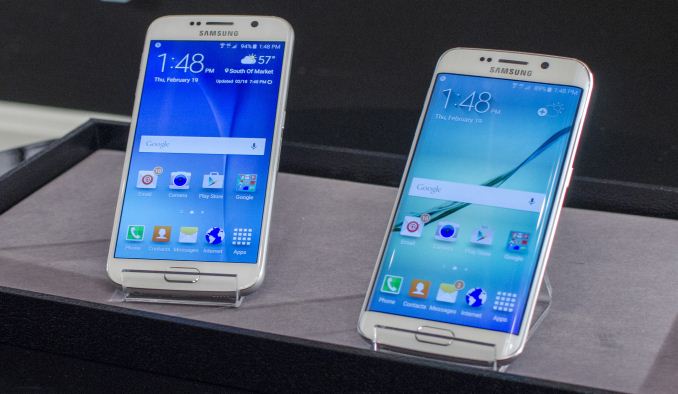
Yesterday we received our Galaxy S6 and S6 edge review units. We’re still working on the final review but I wanted to share some early results from both devices. For those that are unfamiliar with these two phones, the Galaxy S6 range represents the result of Samsung’s “Project Zero”. In fact, the phones seem to have the internal name of Zero, which can be seen in terminal, and the build properties of both devices. For Samsung, these phones represent their attempt at completely rethinking how Samsung makes phones. There is a strong emphasis on a new unibody design, which has no visible gaps or screws. Rather than the plastic that previous Samsung phones have been known for, the new design is composed of metal and glass. Samsung’s design team has been given unprecedented control throughout the process of making this phone and the result of this is a Galaxy phone that looks unlike anything else they’ve ever released.
Even if design is important, it isn’t enough to make the phone. Samsung has also outfitted the Galaxy S6 and S6 edge with their latest technologies, from a new AMOLED display to a new camera module. The specs for both phones can be seen below.
| Samsung Galaxy S5 | Samsung Galaxy S6 | Samsung Galaxy S6 Edge | |
| SoC | MSM8974ACv3 2.45 GHz Snapdragon 801 | Exynos 7420 2.1/1.5GHz A57/A53 | Exynos 7420 2.1/1.5GHz A57/A53 |
| RAM/NAND | 2GB LPDDR3 16/32GB NAND + microSD |
3GB LPDDR4-1552 32/64/128GB NAND |
3GB LPDDR4-1552 32/64/128GB NAND |
| Display | 5.1” 1080p SAMOLED HD |
5.1” 1440p SAMOLED |
5.1” 1440p SAMOLED, Dual Edge |
| Network | 2G / 3G / 4G LTE (Qualcomm MDM9x25 UE Category 4 LTE) | 2G / 3G / 4G LTE (Category 6 LTE) | 2G / 3G / 4G LTE (Category 6 LTE) |
| Dimensions | 142 x 72.5 x 8.1 mm, 145 grams | 143.4 x 70.5 x 6.8mm max, 138 grams | 142.1 x 70.1 x 7.0mm max, 132 grams |
| Camera | 16MP (5132 x 2988) Rear Facing with 1.12 µm pixels, 1/2.6" CMOS size, 31 mm (35mm effective), f/2.2 | 16MP (5132 x 2988) Rear Facing w/ OIS, f/1.9, object tracking AF | 16MP (5132 x 2988) Rear Facing w/ OIS, f/1.9, object tracking AF |
| 2MP Front Facing | 5MP Front Facing, f/1.9 | 5MP Front Facing, f/1.9 | |
| Battery | 2800 mAh (10.78 Whr) | 2550 mAh (9.81 Whr) | 2600 mAh (10.01 Whr) |
| OS | Android 4.4 w/TouchWiz |
Android 5 (64-bit) w/TouchWiz | Android 5 (64-bit) w/TouchWiz |
| Connectivity | 802.11a/b/g/n/ac 2x2 + BT 4.0 (BCM4354), USB3.0, GPS/GNSS, MHL, DLNA, NFC |
2x2 802.11a/b/g/n/ac + BT 4.1 (BCM4358), USB2.0, GPS/GNSS, NFC |
2x2 802.11a/b/g/n/ac + BT 4.1 (BCM4358), USB2.0, GPS/GNSS, NFC |
| Wireless Charging | N/A | WPC 1.1 (4.6W) & PMA 1.0 (4.2W) |
WPC 1.1 (4.6W) & PMA 1.0 (4.2W) |
| Fingerprint Sensor | Swipe | Touch | Touch |
| SIM Size | MicroSIM | NanoSIM | NanoSIM |
Both the Galaxy S6 and S6 edge have Samsung System LSI’s newest SoC, the Exynos 7420, which has a cluster of four Cortex A57s clocked at 2.1 GHz, and four Cortex A53s clocked at 1.5 GHz. Compared to the Exynos 5433 of the Galaxy Note 4, this brings a new 14nm LPE (low power early) process, an upgrade to LPDDR4 memory, and a Mali T760 GPU with two additional shader cores. Outside of the SoC, the new display is advertised to bring a higher 600-nit brightness and a higher 1440p resolution. The front and rear cameras are both different from the Galaxy S5 as well, although the rear camera sensor may be shared between the two as the camera sensors are of similar spec. For this preview, we’ll focus on the system performance and display of these new devices, but as one can see from the specification table there is far more to look at for the full review.
System Performance
For our system performance benchmarks we’ll start with our browser tests which can give a rough proxy for overall CPU performance.
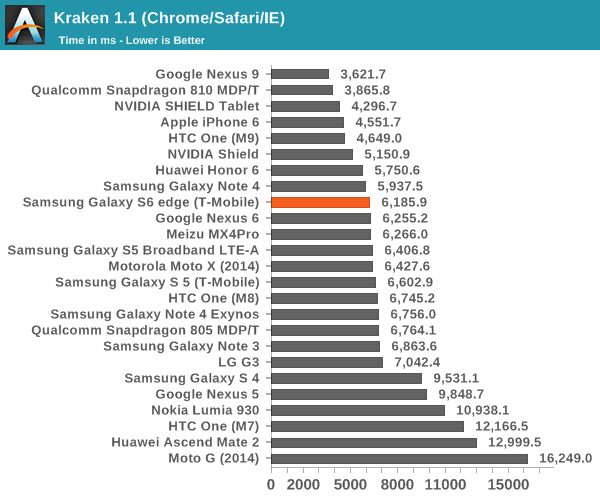
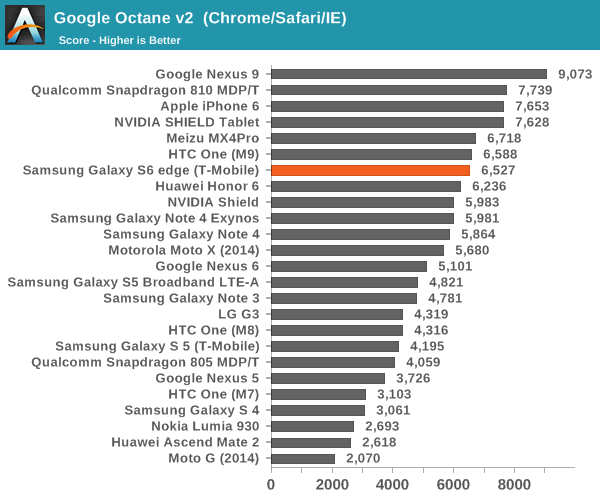
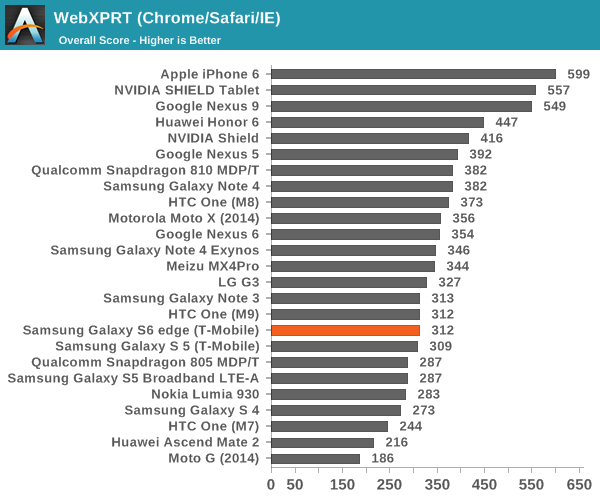
The Exynos 7420 is about on par with the Snapdragon 810 in these benchmarks. Strangely enough both tend to do worse than the Huawei Honor 6 in these tests, which clearly can't be correct. As we've previously discussed, the stock browser will often give far better results due to OEM and SoC vendor optimizations. As a part of our updates to the benchmark suite for 2015, we'll take a look at Basemark OS II 2.0, which should give a better picture of CPU performance in addition to overall device performance.
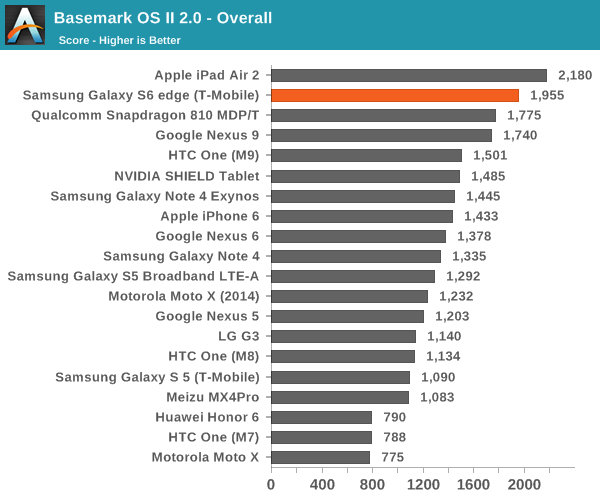
The browser benchmarks seem to hide some pretty enormous variability as the Galaxy S 6 edge (which is comparable to the Galaxy S 6) sets a new record among Android devices. The only challenger is the iPad Air 2, which uses the A8X SoC with three Enhanced Cyclone cores and the semi-custom GXA6850 GPU.
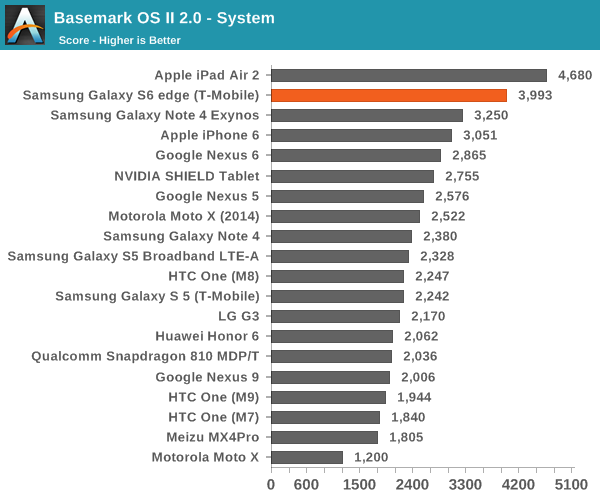
This system test contains a floating point and integer test, in addition XML parsing, which means that this test mostly stresses CPU and RAM. Interestingly enough, the Exynos 7420 pulls far ahead of both the Exynos 5433 and Snapdragon 810 in this test, and approaches the A8X. The difference between the 5433 and 7420 is likely a combination of the higher clocks on both the A57 and A53 clusters for the 7420 (1.9/1.3 on the 5433, 2.1/1.5 on the 7420), in addition to the ability to stay at a high 'overdrive' clock due to reduced leakage from the 14LPE process. The One M9 likely falls a bit short here due to HTC's governor settings restricting the use of all 8 cores simultaneously.
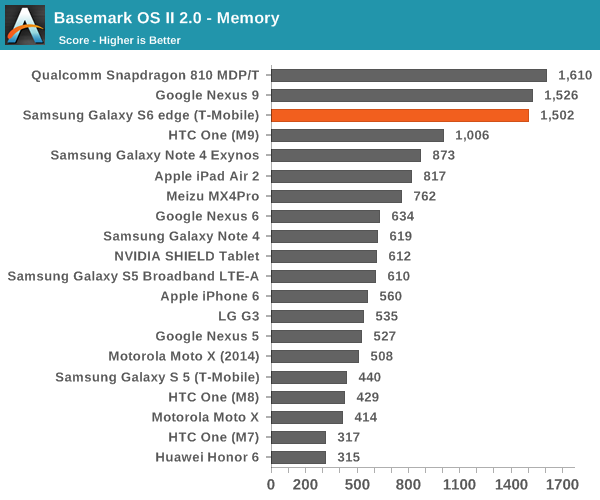
While one might guess that the memory test of 'Basemark OS II 2.0 - Memory' is of RAM, this is actually a test of the internal storage. Once again we see the S6 edge come close to leading the pack due to the use of the new UFS (Universal Flash Storage) standard. Casual examination reveals that the S6 edge has a queue depth of 16, and that it identifies itself with the rather cryptic model name of KLUBG4G1BD-E0B1.
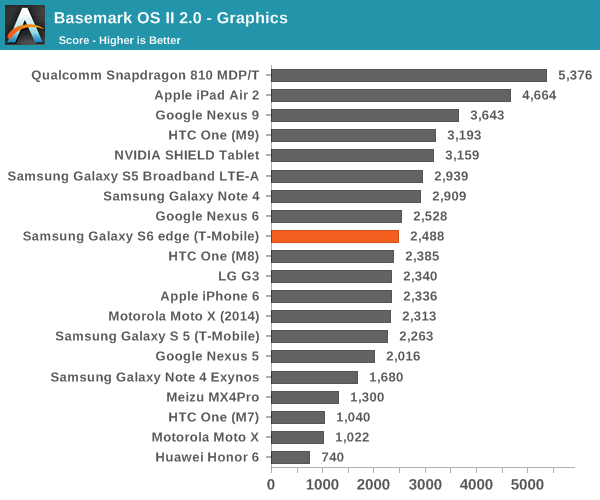
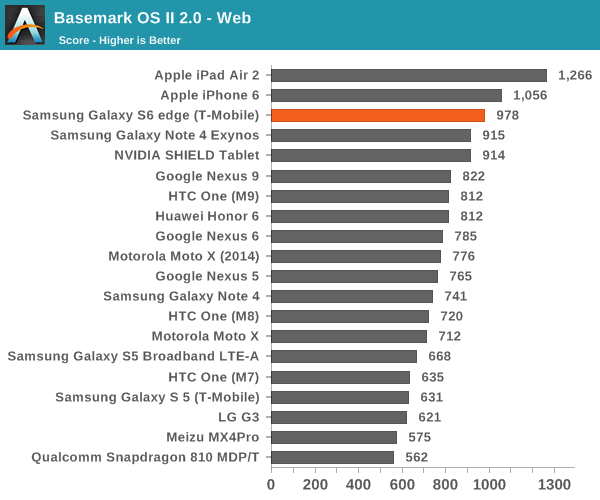
For the web test, it uses the built-in WebView rendering engine rather than Chrome and paints a distinctly different picture, especially because these tests are focused on HTML5 and CSS rather than JavaScript. Here we can see that the iPhone 6 and iPad Air 2 continue to hold their lead, but the Galaxy S6 is pretty much the king of the hill when it comes to Android devices.










200 Comments
View All Comments
Zizy - Thursday, March 26, 2015 - link
Samsung used to have all that, that's the point :)Similar to Windows RT and ChromeOS for example. Similar stuff, but RT is hated for being limited, while ChromeOS is praised for that.
NEDM64 - Thursday, March 26, 2015 - link
So if the iPhone doesn't have, then it's not needed?That's not how to make a superior product.
Chaser - Thursday, March 26, 2015 - link
The first large sized smartphone was invented a few months ago.hrrmph - Friday, March 27, 2015 - link
Exactly correct.As I have tried to get folks to understand repeatedly: the iPhone always was an upper-middle level offering, never a premium high-end flagship phone.
Samsung made the premium high-end hardware. They provided many of the extra features that Apple refused to support...
... and now Samsung is effectively abandoning the premium high-end flagship market by downgrading their offering to the S6. The S6 is, just like the iPhone, an upper-middle market machine.
So who will inherit Samsung's former position at the top of the premium high-end flagship market? HTC, Huawei, LG, Motorola, Sony? Somebody else?
steven75 - Friday, March 27, 2015 - link
The reason you've "tried to get folks to understand repeatedly" is because no one else believes that nonsense.Lonyo - Thursday, March 26, 2015 - link
Well, for me, I could buy a Galaxy S6 to replace my S3, except I got a 128GB MicroSD card for my S3, so why would I want to have to buy the most expensive S6 in order to get less storage (as the S3 also has built in storage), when I could get a competitor's phone which has a MicroSD slot? Samsung removed an upgrade path for me to their newest phone by removing the MicroSD slot. The result? I ordered a different phone to upgrade to (although I've gone the whole hog with a Lumia 640 to try Windows Phone).Existing Galaxy users may have MicroSD cards like I do, and they would then be rendered mostly useless. iPhone users don't have MicroSD cards, so it makes zero difference to them.
makxon - Friday, March 27, 2015 - link
Right dude you can get a midrange phone with micro SD i'm sure its enough of big upgrade from your S3, now "premium" flagship is not all about bang per buck okay, flagship and "premium" phone is arguably only for show. and i'm sure rich people who buy it is not that stingy to decide their next phone just because they already have 128GB microSD ready to use, lolhrrmph - Friday, March 27, 2015 - link
Premium high-end flagships aren't just for show. Samsung was winning because their hardware did more, even though it was wrapped in plastic. I never had a problem with plastic - the best that I've seen is the Blackberry Z10, but Samsung's was never terrible.What Samsung didn't do here was maintain their superiority. If they had put 128GB storage on the inside, and a Micro-SD slot, then then the phone would hold 328GB of storage (SanDisk now has a 200GB Micro-SD chip to fit in the slot).
Today's Micro-SD slots meet the SDXC standard which means that just like hard drives, they are upgradeable to larger sizes as soon as newer chips are made. SDXC supports up to 2TB, even though 200GB is currently the largest.
For folks who need local storage, Samsung was usually double or more the capacity of the iPhone. For example, Apple can't touch 328GB of storage. But, Samsung let the premium high-end flagship market down by not letting us have 328GB of storage.
steven75 - Friday, March 27, 2015 - link
Samsungs sales took a dive and they panicked. Have you not been paying attention?danbob999 - Thursday, March 26, 2015 - link
"This level of progress is amazing from Samsung, given just how bad things were with the Galaxy S' AMOLED display"Am I the only one to find it ironic that the Galaxy S display was considered one of the best by this web site?
"I’d say Samsung’s Super AMOLED is in the running for best display on a smartphone up there with the iPhone 4’s Retina Display. Apple has the resolution advantage, but Samsung has a huge contrast advantage. The former is nicer for reading text, while the latter is better for just about everything else."
http://www.anandtech.com/show/3891/samsung-epic-4g...